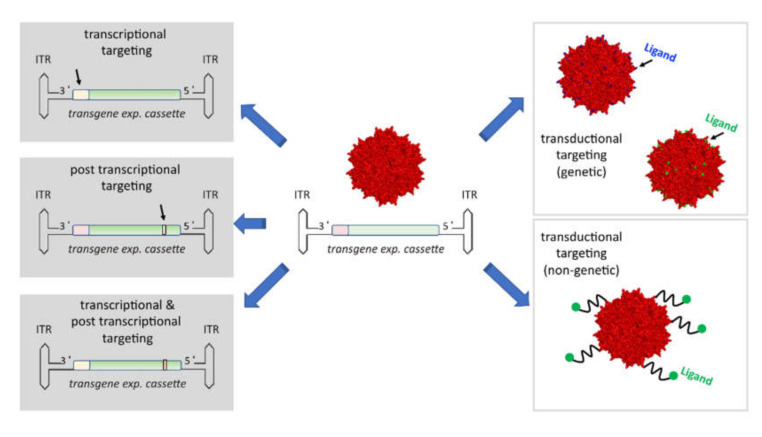Figure 1.
Targeting strategies. In order to restrict transgene expression to distinct cell types, i.e., in the context of cancer gene therapy towards the malignant cell, distinct cell types of the tumor stroma or cells from which factors are secreted like muscle cells or hepatocytes so called targeting strategies have been developed. Of note, targeting strategies focusing on the vector genome can be combined with strategies focusing on modifying the capsid. Vectors based on natural serotype capsids do show a broad tropism albeit tissue preferences such as those discussed for the liver are present. By combining destruction or shielding of natural receptor binding epitopes on the capsid with the introduction of—for the AAV—“foreign” molecules that mediate cell binding and internalization, tropism is re-directed towards a novel vector–receptor interaction. This also impacts on biodistribution, is expected to lower the risk of unspecific uptake in off-target tissues and anti-AAV immune responses. This targeting strategy—known as transductional targeting—is either inserting ligands or cell surface receptor binding molecules genetically or via covalent or non-covalent coupling to the AAV capsid. Both transcriptional and post-transcriptional targeting strategies modulate production of the transgene product, i.e., these strategies do not impact on vector biodistribution. Specifically, in transcriptional targeting approaches natural or synthetic promoters are used to restrict transgene expression in a way that ideally no off-target expression takes place. Alternatively, or in combination with transcriptional targeting, post-transcriptional targeting strategies are applied. In post-transcriptional targeting strategies microRNA targeting sites are used, which when recognized by the corresponding microRNA are leading to the degradation of the microRNA target sites containing mRNA. Since microRNAs are frequently downregulated in malignant cells, post-transcriptional targeting strategies are successfully applied to avoid expression in hepatocytes or other healthy cell types that are prone to damage when expressing the therapeutic transgene. ITR = inverted terminal repeats. Vector genomes are shown schematically with ITRs, promoter and transgene plus poly A sequences. Arrow marks position of promoter or microRNA targeting sites, respectively. Promoter: red = ubiquitously active; yellow = restricted activity. Positions marked in blue on the capsid refer to the tip of the highest capsid protrusion, while green shows the tip of the second highest protrusion. Both peaks are used for genetic insertion of peptide ligands (see main text for details).

